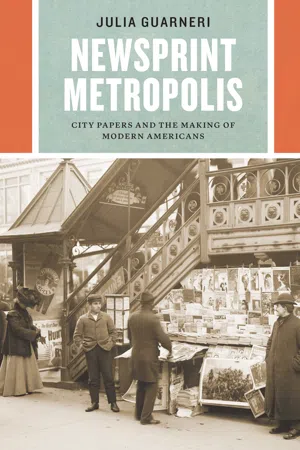1. Collier’s Weekly, 18 February 1911, 7.
2. Letter from Egmont H. Arens in Collier’s Weekly, 30 September 1911, 34. Arens’s essay, along with many others, appeared in a series of Collier’s columns titled “The American Newspaper” that ran through the summer and fall of 1911. The magazine commissioned articles by journalists for the series, too, some of which also appeared under the title “The American Newspaper.”
3. Letter from Curtis C. Brown in Collier’s Weekly, 2 September 1911, 23.
4. Letter from O. H. Chamberlain in Collier’s Weekly, 19 August 1911, 18.
6. Letter from Edward Broderick in Collier’s Weekly, 18 November 1911, 6.
7. Letter from May V. Godfrey in Collier’s Weekly, 2 September 1911, 22.
9. Letter from Curtis C. Brown in Collier’s Weekly, 2 September 1911, 23.
10. Letter from O. H. Chamberlain in Collier’s Weekly, 19 August 1911, 18.
11. Letter from Marjorie Van Horn in Collier’s Weekly, 2 September 1911, 22. When I have quoted Marjorie Van Horn’s essay here and elsewhere, I have kept the original spelling and syntax.
13. Will Irwin, “The American Newspaper: A Study of Journalism and Its Relation to the Public,” pt. 5, “What Is News?” Collier’s Weekly, 18 March 1911, 16. Irwin started as a feature writer at the New York Sun and during the 1920s wrote syndicated pieces for Metropolitan Features.
14. Collier’s Weekly, 8 April 1911, 9, and Collier’s Weekly, 18 February 1911, 7.
15. Thomas C. Leonard, News for All: America’s Coming-of-Age with the Press (New York: Oxford University Press, 1995), 178, drawn from U.S. Census reports and Editor & Publisher.
16. Carl F. Kaestle, Helen Damon-Moore, Lawrence C. Stedman, and Katherine Tinsley, Literacy in the United States: Readers and Reading since 1880 (New Haven, CT: Yale University Press, 1991), 164. The census indicates high literacy rates among most U.S. populations by the late nineteenth century. In 1880, 9 percent of native-born whites over the age of ten reported that they could not write. Among foreign-born whites, the number was 12 percent. An astonishing 70 percent of black respondents reported that they could not write, but that percentage declined rapidly over the next few decades. Carl F. Kaestle, “Seeing the Sites: Readers, Publishers, and Local Print Cultures in 1880,” in A History of the Book in America, vol. 4, Print in Motion: The Expansion of Publishing and Reading in the United States, 1880–1940, ed. Carl F. Kaestle and Janice A. Radway (Chapel Hill: University of North Carolina Press, 2009), 28–29.
17. William R. Merriman, director, prepared under the supervision of S. N. D. North, Twelfth Census of the United States, Taken in the Year 1900, vol. 9, Manufactures, pt. 3: Special Reports on Selected Industries (Washington, DC: U.S. Census Office, 1902), 1051.
18. John L. Given, Making a Newspaper (New York: Henry Holt, 1907), 1–2.
19. The role that newspapers played in creating nations was famously outlined by Benedict Anderson in Imagined Communities: Reflections on the Origin and Spread of Nationalism (New York: Verso, 1991) and has been debated ever since. For discussions of newspapers’ roles (nation-building and otherwise) in the early national United States, see David Paul Nord, “Newspapers and American Nationhood, 1776–1826,” in Communities of Journalism: A History of American Newspapers and Their Readers (Urbana: University of Illinois Press, 2006); Paul Starr, The Creation of the Media: Political Origins of Modern Communications (New York: Basic Books, 2004), pt. 1; Jeffrey L. Pasley, “The Tyranny of Printers”: Newspaper Politics in the Early American Republic (Charlottesville: University Press of Virginia, 2001); and Carol Sue Humphrey, The Press of the Young Republic, 1783–1833 (Westport, CT: Greenwood Press, 1996). In speaking about the public sphere, I am joining the many media historians who have adopted and worked with Jurgen Habermas’s term. Habermas, The Structural Transformation of the Public Sphere: An Inquiry into a Category of Bourgeois Society (Cambridge, MA: MIT Press, 1989). For an incisive discussion of how the idea of a public sphere relates to media and journalism history, see Michael Schudson, “News, Public, Nation,” American Historical Review 107, no. 102 (April 2002): 481–95. Richard Butsch analyzes media audiences as “publics” in The Citizen Audience: Crowds, Publics, and Individuals (New York: Routledge, 2007).
20. On 1830s and 1840s penny papers and their local urban reporting, see James L. Crouthamel, Bennett’s “New York Herald” and the Rise of the Popular Press (Syracuse, NY: Syracuse University Press, 1989); Michael Schudson, Discovering the News: A Social History of American Newspapers (New York: Basic Books, 1978), chap. 1; John D. Stevens, Sensationalism and the New York Press (New York: Columbia University Press, 1991), 1–53; and Andie Tucher, Froth and Scum: Truth, Beauty, Goodness, and the Ax Murder in America’s First Mass Medium (Chapel Hill: University of North Carolina Press, 1994).
21. On the diversifying readership of turn-of-the-century newspapers, see Leonard, News for All; Gerald J. Baldasty, The Commercialization of News in the Nineteenth Century (Madison: University of Wisconsin Press, 1992); and David Paul Nord, “Working-Class Readers: Family, Community, and Reading in Late Nineteenth-Century America,” in Communities of Journalism. On women’s increasing presence on newspaper staffs, see Alice Fahs, Out on Assignment: Newspaper Women and the Making of Modern Public Space (Chapel Hill: University of North Carolina Press, 2011); and Jan Whitt, Women in American Journalism: A New History (Urbana: University of Illinois Press, 2008). There has been little written on immigrant journalists as a group, but their ranks include Joseph Pulitzer, editor of the New York World; S. S. McClure, founder of the McClure syndicate; Prosper Fiorini (pen name: Maurice Ketten) and Valerian Gribayedoff, New York World cartoonists; and Rudolph Dirks, creator of the Katzenjammer Kids comic strip.
22. The most concrete evidence of this special influence comes from a sociologist’s survey performed after the scope of this study, in 1945. New Yorkers described what they missed about their daily newspapers during a seventeen-day news carriers’ strik...
